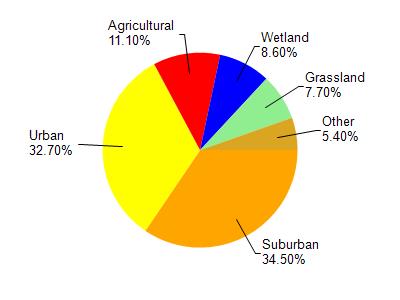Milwaukee
No
No
No
Fish and Aquatic Life
Overview
Greenfield Park Pond is an irregular pond constructed in 1920, part of a 287-acre county park. The pond receives water from a well (500 feet deep) in Niagra dolomite. The expected specific conductance to alkalinity ratio is greatly exceeded, indicating an irregularity in water quality due to noncarbonate materials. The water is clear over gravel and clay, and presumably supports carp and bullheads, since the pond is used for fishing. A park-controlled livery provides boating; in addition the pond is used for skating and as a duck sanctuary, where fair numbers of waterfowl may be seen. Overnight camping is provided within the park bounds.
Date 1964
Author Aquatic Biologist
Management Goals
Wisconsin's Water Quality Standards provide qualitative and quantitative goals for waters that are protective of Fishable, Swimmable conditions [Learn more]. Waters that do not meet water quality standards are considered impaired and restoration actions are planned and carried out until the water is once again fishable and swimmable
Management goals can include creation or implementation of a Total Maximum Daily Load analysis, a Nine Key Element Plan, or other restoration work, education and outreach and more. If specific recommendations exist for this water, they will be displayed below online.
Monitoring
Monitoring the condition of a river, stream, or lake includes gathering physical, chemical, biological, and habitat data. Comprehensive studies often gather all these parameters in great detail, while lighter assessment events will involve sampling physical, chemical and biological data such as macroinvertebrates. Aquatic macroinvertebrates and fish communities integrate watershed or catchment condition, providing great insight into overall ecosystem health. Chemical and habitat parameters tell researchers more about human induced problems including contaminated runoff, point source dischargers, or habitat issues that foster or limit the potential of aquatic communities to thrive in a given area. Wisconsin's Water Monitoring Strategy was recenty updated.
Grants and Management Projects
Monitoring Projects
| WBIC | Official Waterbody Name | Station ID | Station Name | Earliest Fieldwork Date | Latest Fieldwork Date | View Station | View Data |
|---|
| 200 | Greenfield Park Pond | 10040090 | Milwaukee Co. Parks - Greenfield Park - 3 | 7/3/2014 | 8/28/2014 | Map | Data |
| 200 | Greenfield Park Pond | 104403 | Greenfield Park Pond | | | Map | Data |
| 200 | Greenfield Park Pond | 10007833 | Greenfield Park Pond - Greenfield Park Pond | 8/1/1985 | 8/7/2024 | Map | Data |
| 200 | Greenfield Park Pond | 104432 | Greenfield Park Pond | | | Map | Data |
| 200 | Greenfield Park Pond | 10045239 | Phragmites Occurrence - Greenfield Park Pond - 3 | | | Map | Data |
|

Watershed Characteristics
Greenfield Park Pond is located in the Menomonee River watershed which is 136.12 mi². Land use in the watershed is primarily suburban (34.50%), urban (32.70%) and a mix of agricultural (11.10%) and other uses (21.70%). This watershed has 174.17 stream miles, 352.64 lake acres and 5,967.40 wetland acres.
Nonpoint Source Characteristics
This watershed is ranked High for runoff impacts on streams, High for runoff impacts on lakes and High for runoff impacts on groundwater and therefore has an overall rank of High. This value can be used in ranking the watershed or individual waterbodies for grant funding under state and county programs.However, all waters are affected by diffuse pollutant sources regardless of initial water quality. Applications for specific runoff projects under state or county grant programs may be pursued. For more information, go to surface water program grants.